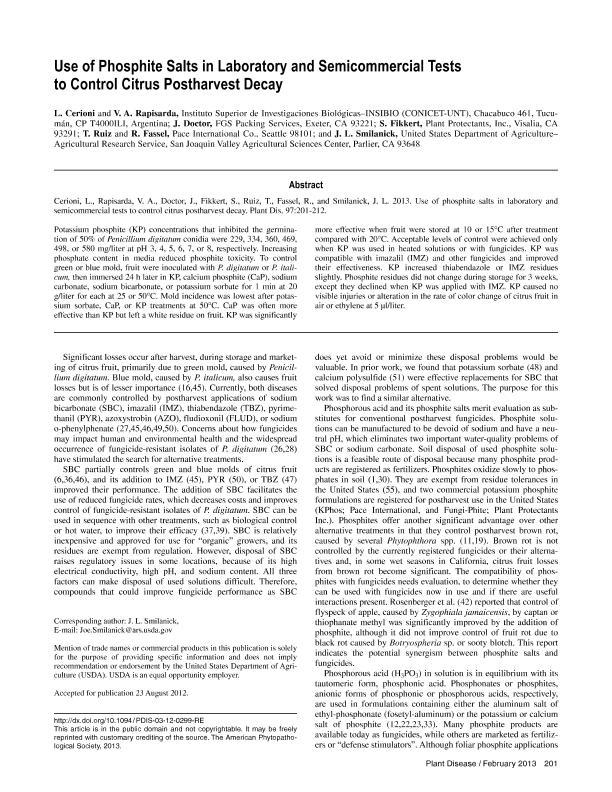Mostrar el registro sencillo del ítem
dc.contributor.author
Cerioni, Luciana

dc.contributor.author
Rapisarda, Viviana Andrea

dc.contributor.author
Doctor, J.
dc.contributor.author
Fikkert, S.
dc.contributor.author
Ruiz, T.
dc.contributor.author
Fassel, R.
dc.contributor.author
Smilanick, J. L.
dc.date.available
2017-08-23T17:13:36Z
dc.date.issued
2013-02
dc.identifier.citation
Cerioni, Luciana; Rapisarda, Viviana Andrea; Doctor, J.; Fikkert, S.; Ruiz, T.; et al.; Use of phosphite salts in laboratory and semicommercial tests to control citrus postharvest decay ; American Phytopathological Society; Plant Disease; 97; 2; 2-2013; 201-212
dc.identifier.issn
0191-2917
dc.identifier.uri
http://hdl.handle.net/11336/22834
dc.description.abstract
Potassium phosphite (KP) concentrations that inhibited the germination of 50% of Penicillium digitatum conidia were 229, 334, 360, 469, 498, or 580 mg/liter at pH 3, 4, 5, 6, 7, or 8, respectively. Increasing phosphate content in media reduced phosphite toxicity. To control green or blue mold, fruit were inoculated with P. digitatum or P. italicum, then immersed 24 h later in KP, calcium phosphite (CaP), sodium carbonate, sodium bicarbonate, or potassium sorbate for 1 min at 20 g/liter for each at 25 or 50°C. Mold incidence was lowest after potassium sorbate, CaP, or KP treatments at 50°C. CaP was often more effective than KP but left a white residue on fruit. KP was significantly more effective when fruit were stored at 10 or 15°C after treatment compared with 20°C. Acceptable levels of control were achieved only when KP was used in heated solutions or with fungicides. KP was compatible with imazalil (IMZ) and other fungicides and improved their effectiveness. KP increased thiabendazole or IMZ residues slightly. Phosphite residues did not change during storage for 3 weeks, except they declined when KP was applied with IMZ. KP caused no visible injuries or alteration in the rate of color change of citrus fruit in air or ethylene at 5 µl/liter.
dc.format
application/pdf
dc.language.iso
eng
dc.publisher
American Phytopathological Society

dc.rights
info:eu-repo/semantics/openAccess
dc.rights.uri
https://creativecommons.org/licenses/by-nc-sa/2.5/ar/
dc.subject
Green Mold
dc.subject
Phosphite Salts
dc.title
Use of phosphite salts in laboratory and semicommercial tests to control citrus postharvest decay
dc.type
info:eu-repo/semantics/article
dc.type
info:ar-repo/semantics/artículo
dc.type
info:eu-repo/semantics/publishedVersion
dc.date.updated
2017-08-07T17:37:22Z
dc.journal.volume
97
dc.journal.number
2
dc.journal.pagination
201-212
dc.journal.pais
Estados Unidos

dc.description.fil
Fil: Cerioni, Luciana. Consejo Nacional de Investigaciones Científicas y Técnicas. Centro Científico Tecnológico Conicet - Tucumán. Instituto Superior de Investigaciones Biológicas. Universidad Nacional de Tucumán. Instituto Superior de Investigaciones Biológicas; Argentina
dc.description.fil
Fil: Rapisarda, Viviana Andrea. Consejo Nacional de Investigaciones Científicas y Técnicas. Centro Científico Tecnológico Conicet - Tucumán. Instituto Superior de Investigaciones Biológicas. Universidad Nacional de Tucumán. Instituto Superior de Investigaciones Biológicas; Argentina
dc.description.fil
Fil: Doctor, J.. Fruit Growers Supply Packing Services; Estados Unidos
dc.description.fil
Fil: Fikkert, S.. Plant Protectants; Estados Unidos
dc.description.fil
Fil: Ruiz, T.. Pace International; Estados Unidos
dc.description.fil
Fil: Fassel, R.. Pace International; Estados Unidos
dc.description.fil
Fil: Smilanick, J. L.. United States Department of Agriculture; Estados Unidos
dc.journal.title
Plant Disease

dc.relation.alternativeid
info:eu-repo/semantics/altIdentifier/doi/http://dx.doi.org/10.1094/PDIS-03-12-0299-RE
dc.relation.alternativeid
info:eu-repo/semantics/altIdentifier/url/http://apsjournals.apsnet.org/doi/10.1094/PDIS-03-12-0299-RE
Archivos asociados
